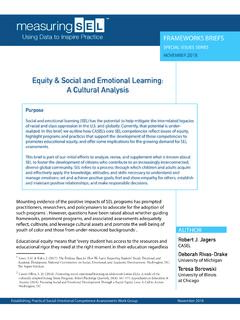Transcription of SOCIAL NETWORKING USAGE QUESTIONNAIRE: …
1 214 Turkish Online Journal of Distance Education-TOJDE October 2018 ISSN 1302-6488 Volume: 19 Number: 4 Article 13 SOCIAL NETWORKING USAGE QUESTIONNAIRE: DEVELOPMENT AND VALIDATION IN AN INDIAN HIGHER EDUCATION CONTEXT Dr. Savita GUPTA Faculty of Education Lovely Professional University Phagwara, India Liyaqat BASHIR Department of Education Lovely Professional University Phagwara, India ABSTRACT The concept of SOCIAL NETWORKING has received much attention from academia over the last decade in India. Widespread research has conceptualized the term SOCIAL NETWORKING with almost all of the studies either conceptual or based on case studies.
2 This paper is an attempt to clarify the construct of SOCIAL NETWORKING by developing a reliable and valid questionnaire measuring SOCIAL NETWORKING USAGE . 420 university students from 6 universities in Jammu and Kashmir were surveyed via a random sampling technique and factor analysis carried out on their responses. The findings revealed that SOCIAL NETWORKING USAGE can be decomposed into four factors: academic; socialization; entertainment and informativeness. The internal consistency indices, Cronbach s alpha of SOCIAL NETWORKING USAGE ( = .830) indicates good internal reliability.
3 The findings revealed that the newly developed questionnaire has significant psychometric features. Keywords: SOCIAL NETWORKING USAGE , university students, scale development, factor analysis. INTRODUCTION SOCIAL NETWORKING USAGE refers to online space that is used by students to connect, share, communicate, establish or maintain connection with others for academic, entertainment, socialization etc. SOCIAL NETWORKING as a communication medium is rising quickly, mostly in the prosperous increase of applications for mobile devices. Especially young adults are becoming familiar with sharing their everyday life and experiences, keeping in touch with teachers, friends, and family online and talking about their interests (Leung 2002; Morahan-Martin & Schumacher 2003).
4 The past few years have observed an explosion of SOCIAL NETWORKING such as Twitter, Facebook etc. which have added a fresh SOCIAL dimension to the web. There have been a rapidly increasing number of online connections among groups of persons who share similar interests, though they are assembled in an absolute space (Wilson 2002). A number of SOCIAL NETWORKING sites ( , Twitter, Facebook, LinkedIn, Google plus, Orkut, Google plus) have employed dynamic SOCIAL contexts in which online communities can be made and continued easily by the facilitation of communications and SOCIAL connections among users.
5 Such NETWORKING opportunities help make groups, communities and people with shared interests remain more associated. In recent years, SOCIAL NETWORKING sites have been the prevalent tools for online communication combining the interpersonal and mass communication competences 215 together (Pempek, et al; 2009; Boyd & Ellison, 2007). SOCIAL NETWORKING sites like Twitter, LinkedIn, and Facebook support online groups that allow users to broadcast and construct their profile information, and interact with others by sending personal and public messages, playing games, and sharing photos (Pempek, Yermolayeva, & Calvert, 2009; Boyd & Ellison, 2007).
6 SOCIAL NETWORKING sites facilitate individuals, making new online friends and acquaintances, and to maintain pre-existing SOCIAL connections (Ellison, Lampe, & Steinfield, 2007). The majority of users of the SOCIAL NETWORKING sites are young people (14 to 25 year olds) who were named by Prensky (2001), as Digital Natives especially represented at the moment by students in higher education. These digital natives often use SOCIAL NETWORKING sites to connect with their offline peers to strengthen their existing relations rather than building new relationships, (Ellison, Steinfield, & Lampe, 2007; Waechter, Reich, Espinoza, &, Subrahmanyam, 2008).
7 SOCIAL NETWORKING sites might provide a potential medium to attain deeper online knowledge than conventional e-learning platforms, if educationally-focused actions can be closely integrated into the use of SOCIAL NETWORKING sites (Srivastava, 2012). Moreover, SOCIAL NETWORKING sites allow students to highlight their experiences and talents, and communicate and express themselves better. The advantages of using SOCIAL NETWORKING sites for educational purpose are far ranging. A study stated that the use of SOCIAL NETWORKING tools improved student s learning opportunities, allowed for real-time communication outside the classroom, fostered collaborative opportunities, and enhanced creativity (George, & Dellasega, 2011).
8 Learners can watch educationally relevant videos or exchange information about what they have watched and learned, and then join online to further discuss with teachers. Even the teachers can learn from the students during SOCIAL NETWORKING interactions. Similarly, a teacher can supervise students while they are learning, reflecting, sharing, interacting and summarizing discussions. SOCIAL NETWORKING sites provide a forum to contact peers and teachers from wherever they are, offering the flexibility of extended duty hours. Some SOCIAL NETWORKING sites, especially Facebook, features may boost students to involve in SOCIAL and creative learning progressions that extend beyond traditional educational settings and institutions (Wiberg, 2007).
9 This provides added benefit to access extensive and different sources of information and opportunities for communication (Anderson, & Dron, 2007). At present, a lot of educational institutions are making use of the advantages of SOCIAL networks in the teaching and learning process. According to the results of the study conducted by the Department of Education (2009), the classes using SOCIAL networks or online systems were found to be more effective than the classes using the traditional face-to-face instruction. Given the collaborative and interactive nature that describes SOCIAL NETWORKING has tremendous potential for the field of education.
10 Universities and Colleges are beginning to embrace SOCIAL NETWORKING and understanding the potential power and implications for using it in education. Blankenship (2010) indicated that the USAGE of SOCIAL NETWORKING in education results in many benefits, such as greater student interest, greater student engagement, more responsibility for their education and students take more control over their education. It also indicates that SOCIAL NETWORKING sites support educational activities by creating interaction, collaboration, and active participation. In similar way Abdulahi et al., (2014) & Ahn, (2011) noted that SOCIAL NETWORKING and media tools offer students the opportunity to communicate, access information, get in touch, chat and research.















